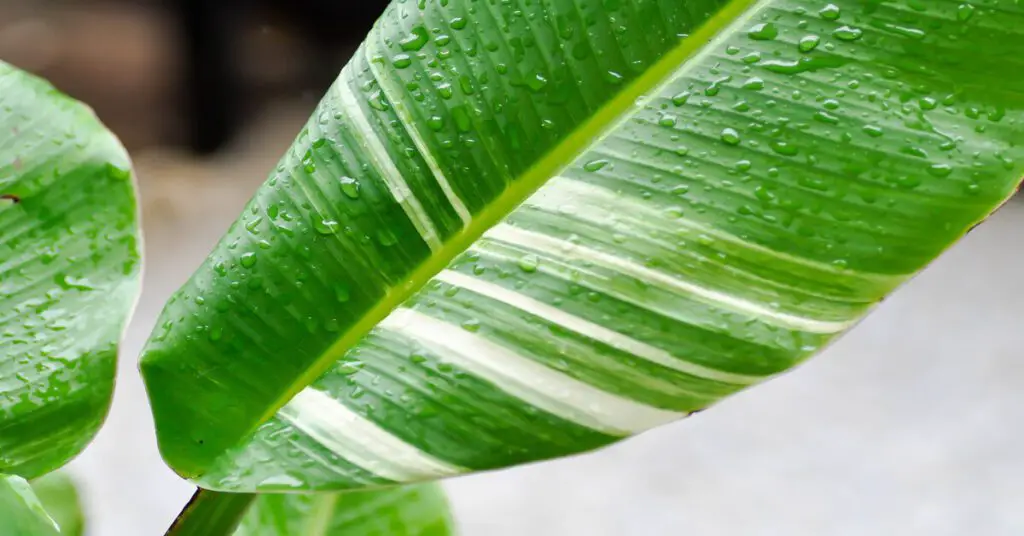Said to originate from Hawaii (by way of Polynesia). The Variegated Banana Tree or Musa x paradisiaca “Ae Ae” is a highly sought-after, hybrid banana plant. Known for its white-striped variegated foliage, trunk, and fruit.
Other common names for this beautiful cultivar include Royal Variegated Banana Plant, Variegated Hawaiian Banana, Sacred Banana, Variegated Musa, or Musa “Ae Ae” or “Aeae” (which means “ hair prematurely graying” in the Hawaiian language).
Like most other edible bananas, Musa “Ae Ae” is a mutated hybrid of two common banana species. Musa acuminata and Musa balbisiana. Hybrids of these two species are sometimes also called Musa x paradisiaca for short.
Variegated Banana Tree Care
Popularized in Southern Florida in the 1950s to the U.S. mainland, Musa “Ae Ae” has met with varying success as an ornamental landscaping plant.
These plants require sandy and acidic well-draining soils, adequate water, a healthy amount of fertilizer. As well as plenty of direct sunlight to thrive. They reach average heights between 9-15 ft. (3-4.5 m) or up to 25 ft (8 m) in ideal tropical conditions.
These plants have also become exceptionally rare in the United States due to the recent 2021 import ban on banana plants (Musa spp.) [1].
When cared for properly, these exotic hardy plants not only flower and bear fruit year round, but also bring a dramatic and rare tropical flair to your landscaping.
Variegated Banana Tree Suckers

The Musa Ae Ae is said to be an unstable mutation that produces not only variegated suckers, but also suckers in all degrees of mixtures from pure green to pure white.
Pure white suckers lack chlorophyll and will not propagate. So care should be placed in choosing the right suckers when propagating these plants to preserve the variegation.
Variegated Banana Tree Seeds
Most cultivated bananas, including the Musa Ae Ae, are highly female sterile. Meaning they produce no seeds and can only be reproduced via clonal or vegetative propagation [2].
Moreover, the Musa Ae Ae is an unstable chimeric mutation. So, there’s no guarantee the variegation will be preserved in subsequent generations.
For best chance at propagating the variegation, choose a sucker with plenty of mutant tissue (i.e. variegation).
White Variegated Banana Trees
-
Musa Ae Ae Royal Hawaiian
This is often considered the more “standard” of the well-known green/white variegated banana plants. Royal Hawaiians (aka Musa Aeae) produce fruits that are rounder at the ends and are said to taste better after cooked.
-
Musa Florida
This plant is said to be a hardier modified strain of variegated banana plants of unknown parentage that closely resemble the Musa Aeae. Some say it can be distinguished from the Aeae for the presence of seeds in its pointier banana fruit vs. the seedless, rounder Ae Ae fruit. The fruit is also said to taste more like a dessert banana. [3]
-
Musa Thai Variegated
There are a few variegated Thai varieties of banana plants that resemble the Aeae. Including the variegated Musa “Nam wah” and Musa “Tanna.” The Thai varieties are said to be more cold-hardy and tougher than the original Aeae. Leaves and petioles are also said to be glossy, slender, and longer than the Musa Aeae.
Red Variegated Banana Trees

-
Zebrina (blood banana)
Also known as blood banana, this variety is named for the dark red patches on its leaves. These plants are largely ornamental, but produce smaller slender edible bananas with seeds.
-
Red tiger
Also known as the Darjeeling Banana (or Musa sikkimensis), these cold-hardy bananas come from Bhutan and India. And said to produce beautiful paddle-shaped yellowish-green foliage with reddish tinged pseudostem.
-
Siam ruby
Also known as the red banana tree for their stunning variegated ruby red leaves with tiny green flecks. These plants love heat and humidity, which turn their leaves redder.
Musa Ae Ae vs Musa Florida
There is open debate about the relationship between Musa Ae Ae and Musa florida. Internet forums say the Musa florida may actually be a version of the Ae Ae that was imported into Thailand, modified, then re-exported.
Notable differences include a rounder fruit on the Aeae vs. the Musa florida’s pointier fruit. Some say the Musa florida also produces a fruit that is more like a dessert banana than the Aeae. Which is more like a plantain and needs cooking. Also, the Musa florida may contain seeds, which the Aeae lacks [3].
Variegated Banana Tree Price
Variegated Musa Ae Ae are exceedingly rare, as they cannot be imported. And do not produce seeds, and must be produced from suckers that also display variegation. Prices online for the plant can go anywhere from $100 to thousands of dollars. Though authenticity is questionable with lower-priced items.
References
[1] El-Lissy, O., (2021) Fusarium oxysporum f. sp. cubense Tropical race 4 (Foc TR4) Import Restrictions. USDA Animal and Plant Health Inspection Service. Retrieved October 11, 2022, from https://www.aphis.usda.gov/aphis/newsroom/stakeholder-info/stakeholder-messages/ plant-health-news/da-2021-06.
[2] Pillay, M., et al (2004). Molecular characterization of genomes in Musa and its applications. In S. M. Jain (Ed.), Banana Improvement: Cellular, Molecular Biology and Induced Mutations (pp. 271–286). Science Publishers, Inc. Retrieved October 11, 2022, from https://www.fao.org/3/ae216e/ae216e0p.htm.
[3] Variegated Musa “Florida” [Online forum post], (2011). Bananas.org. Retrieved October 11, 2022, from http://www.bananas.org/f2/variegated-musa-florida-13178.html.

